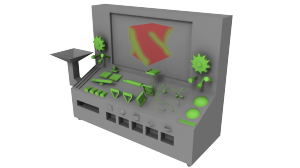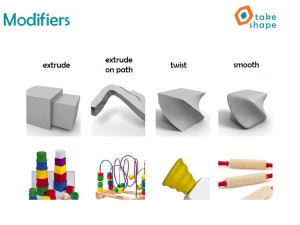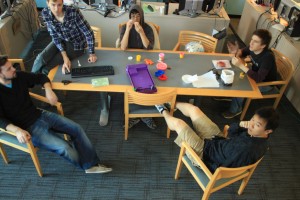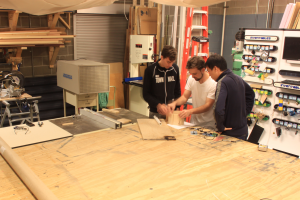Project: Take Shape
Week Four Newsletter
9-21-2012
Week Four – The Internal Launch
With the branding aspects of our project completed the Take Shape team sat down Monday morning and brainstormed on how to finalize our final pitch idea for our client meeting only two days away. From the first meeting we discovered which aspects the client liked, what fit in the MAKESHOP’s aesthetic style and, what we as the developers, could feasibly create in a single semester.
We have been narrowing down on an idea that involves the children placing physical shapes into a machine that will instantly ‘digitize’ these shapes, display the corresponding primitives on the screen, and, through a set of physical input devices, will be able to manipulate the objects on the screen. This design is centered on the idea of showing children the constraints of manipulation in the real world. It is difficult to stretch, pull, bend or twist a physical object; but once it is put into our special machine children will have the ability to affect the model in a variety of ways.  To reinsure the Maker culture we want to focus on the real, the tangible and the types of inputs that relate to real life processes. So, in order for the guest to twist the model on screen, they must twist the modifier controller in order to do so. Following that example we will have a physical input device for each modifier including, but not limited to, skew, stretch, bend, squeeze, extrude, multiply or mirror. Through this process we hope to drive home the basic types of operators available in 3D modeling software packages.
To reinsure the Maker culture we want to focus on the real, the tangible and the types of inputs that relate to real life processes. So, in order for the guest to twist the model on screen, they must twist the modifier controller in order to do so. Following that example we will have a physical input device for each modifier including, but not limited to, skew, stretch, bend, squeeze, extrude, multiply or mirror. Through this process we hope to drive home the basic types of operators available in 3D modeling software packages.
After meeting as a team and fine tuning our idea we needed to prepare for our upcoming client meeting; the one where we’d find out if our train of thought was headed down the appropriate tracks. To do this, Kevin made a second mock up for a Visual Design packet to highlight the two visual styles we will be pulling from. In this document we also highlighted each digital modifier to a potential of what its physical input could look like.  For our client, this was helpful to envision physical manipulation having an effect on a digital object. Ryan also revisited our experience packet that clearly highlighted each step of the process to show what we believe will take place throughout a child’s interaction cycle. Not only did we show the positives of each but made sure to include areas we are slightly concerned or simply unsure how it could pan out in hopes our client would be able to fill in the blanks.
For our client, this was helpful to envision physical manipulation having an effect on a digital object. Ryan also revisited our experience packet that clearly highlighted each step of the process to show what we believe will take place throughout a child’s interaction cycle. Not only did we show the positives of each but made sure to include areas we are slightly concerned or simply unsure how it could pan out in hopes our client would be able to fill in the blanks.
On Wednesday morning we met with our client, Lisa Brahms, in the Red Café adjacent to the MAKESHOP. As whole we reviewed our two packets and exchanged thoughts and questions for roughly an hour. At the end of the meeting we had a thrilled client who was overly excited to see the direction in which our project is headed. As a team this was a huge relief to know we are on the same wave lengths as our client; that the work we are preparing to accomplish is meaningful, relative and valuable to our client.
Returning to the ETC afterwards was thrilling. All group members donned big smiles for both the successful meeting we had as well as the work we were now able to begin. Prior to getting confirmation from our client we were weary of building too much or working towards one direction and having the project shift enough to where such work would be rendered futile.

We soon began work on the next phases of our project. Mainly, our next big milestone is the upcoming quarter walkthrough done by faculty and staff. This is a period in the semester when groups of ETC faculty and staff visit each project room during a twenty minute window. In this time frame we will have to give a project overview to show the status of our project as clearly as we can in order to receive as much feedback as possible. In order to prepare for this we met with a few adjunct members to the ETC’s staff. Anthony Daniels, also known as C3P0 from Star Wars; Jessica Trybus, ETC alumni and the founder/CEO of Etcetera Edutainment; Evan Hirsch, an industry professional for many years; all met with our group in the past week to discuss our project in detail. Many great points were made that either helped us see our own project in a different light or to simply become better at articulating the complex system we are hoping to develop.
Between our meetings we got to work on building a prototype to help demonstrate our physical to digital interface of modifiers. The first modifier we are working to complete will be the twist function. To start we are basing all of our hardware on the Phidget system; an analog system that has a variety of sensors that will communicate a wide range of information into our Unity 3D based game engine. The twist modifier is comprised of a wooden box with a piece of PVC pipe running through the center. Attached to this pipe is single steel bolt that, when mounted perpendicular to the pipe, comes close to touching the interior walls of the box. On these walls we have mounted four analog touch sensors that are simple on and off switches. The fun part comes when detecting the order in which the sensors are touched; with this information we can determine the direction and speed of the twist mechanism to directly manipulate the 3D model the child will see on the screen in front of them.
Attached to this pipe is single steel bolt that, when mounted perpendicular to the pipe, comes close to touching the interior walls of the box. On these walls we have mounted four analog touch sensors that are simple on and off switches. The fun part comes when detecting the order in which the sensors are touched; with this information we can determine the direction and speed of the twist mechanism to directly manipulate the 3D model the child will see on the screen in front of them.
We are excited for walkthroughs this coming week and anticipate lots of positive and constructive feedback that will help polish our direction and form a concrete deliverable. With hopeful approval from the faculty and staff we will soon be taking our prototypes to the MAKESHOP to get a firsthand look at how the children interact with our mini exhibit. Playtesting will be an integral part in shaping our machine into a well-rounded and valuable experience for each child that wishes to explore the fundamentals of 3D modeling.
With more prototypes to come the Take Shape team is eager to see the growth of this exhibit and to realizing the full potential of a unique concept. In the next few weeks we will have lots of exciting updates on hardware, software, art and experience design including feedback from within the Entertainment Technology Center.
Until next time!